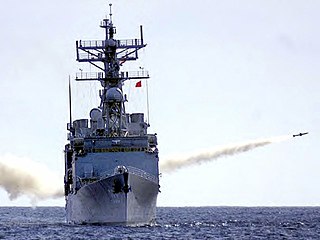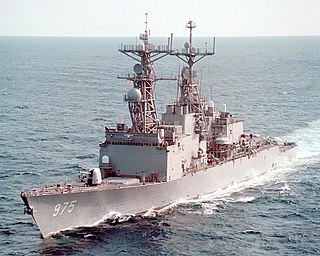
USS Lynde McCormick (DD-958/DDG-8) was a Charles F. Adams-class destroyer in the United States Navy.

USS Newman K. Perry (DD-883/DDR-883), was a Gearing-class destroyer of the United States Navy.

USS Paul F. Foster (DD-964), named for Vice Admiral Paul F. Foster USN (1889–1972), is a Spruance-class destroyer built by the Ingalls Shipbuilding Division of Litton Industries at Pascagoula, Mississippi. She was commissioned on 21 February 1976 and decommissioned on 27 March 2003. She is now ex-Paul F. Foster, serving as a Self Defense Test Ship for experimental U.S. Navy weapons and sensors. She is the last Spruance-class destroyer still afloat.

USS Kinkaid (DD-965), named for Admiral Thomas C. Kinkaid USN (1888–1972), was a Spruance-class destroyer built by the Ingalls Shipbuilding Division of Litton Industries at Pascagoula, Mississippi. Launched in 1974, she was decommissioned in 2003 and sunk in 2004. She was the third "Spru-can" to be built.

USS Hewitt (DD-966), named for Admiral H. Kent Hewitt USN (1887–1972), was a Spruance-class destroyer built by the Ingalls Shipbuilding Division of Litton Industries at Pascagoula, Mississippi and launched on 14 September 1974 by Mrs. Leroy Hewitt Taylor and Mrs. Gerald Hewitt Norton, daughters of Admiral Hewitt.

USS Elliot (DD-967) was a Spruance-class destroyer in the United States Navy. Built by the Ingalls Shipbuilding Division of Litton Industries at Pascagoula, Mississippi, the ship was named for Lieutenant Commander Arthur J. Elliot II, USN (1933–1968), who as commanding officer of Patrol Boat River Squadron 57, was killed in action in the Republic of Vietnam on 29 December 1968.

USS David R. Ray (DD-971), was a Spruance-class destroyer named for United States Navy Hospital Corpsman Second Class David Robert Ray who was killed in action in 1969 while assigned to a Marine Corps artillery unit during the Vietnam War and posthumously awarded the Medal of Honor.

USS Oldendorf (DD-972), named for Admiral Jesse B. Oldendorf USN, was a Spruance-class destroyer built by the Ingalls Shipbuilding Division of Litton Industries at Pascagoula, Mississippi.

USS O'Brien (DD-975) was a Spruance-class destroyer built by the Ingalls Shipbuilding Division of Litton Industries at Pascagoula, Mississippi. It was named for Captain Jeremiah O'Brien and his five brothers: Gideon, John, William, Dennis and Joseph. The O'Briens were crew members on board the sloop Unity, which captured HMS Margaretta at the entrance to Machias harbor on 12 June 1775. O’Brien was decommissioned on 24 September 2004, and was later sunk as part of a training exercise in 2006.

USS Merrill (DD-976), named for Rear Admiral Aaron Stanton Merrill USN (1890–1961), was a Spruance-class destroyer that entered service with the United States Navy in 1978. Merrill served as the US Navy's test platform for the Tomahawk cruise missile. In the 1980s, the destroyer took part in Operation Earnest Will in the Persian Gulf during heightened tensions with Iran. The destroyer was decommissioned in 1998. The vessel was used as a target ship in 2003 and sunk off Hawaii in 2003.

USS Stump (DD-978) was a Spruance-class destroyer built by the Ingalls Shipbuilding Division of Litton Industries at Pascagoula, Mississippi. The USS Stump was decommissioned and stricken on 22 October 2004.

USS Conolly (DD-979), named for Admiral Richard Lansing Conolly USN, was a Spruance-class destroyer built by the Ingalls Shipbuilding Division of Litton Industries at Pascagoula, Mississippi.

USS Leftwich (DD-984) was a Spruance-class destroyer built by the Ingalls Shipbuilding Division of Litton Industries at Pascagoula, Mississippi. She was named for Lieutenant Colonel William G. Leftwich, Jr., USMC (1931–1970), commander of the 1st Reconnaissance Battalion who was killed in action during Operation Imperial Lake in Quảng Nam Province South Vietnam on 18 November 1970 in a helicopter crash during the extraction of one of his reconnaissance teams. For this action, Lieutenant Colonel Leftwich received the Silver Star. Lieutenant Colonel Leftwich's medals and awards include: the Navy Cross, the Silver Star (posthumous), the Legion of Merit with Combat "V" and two gold stars, the Meritorious Service Medal, the Air Medal with one gold star, the Purple Heart with two gold stars, and various personal awards from the Republic of Vietnam.

USS Cushing (DD-985), named after Commander William Barker Cushing, was the fifth ship of the United States Navy to bear the name. Cushing was a Spruance-class destroyer built by the Ingalls Shipbuilding Division of Litton Industries at Pascagoula, Mississippi. Cushing operated out of Yokosuka, Japan for the last several years of her career. Cushing was the last Spruance-class destroyer to remain in active service, until decommissioned on 21 September 2005.

USS Crommelin (FFG-37), twenty-eighth ship of the Oliver Hazard Perry-class of guided-missile frigates, was named for five brothers: Rear Admiral John G. Crommelin (1902–1996), Vice Admiral Henry Crommelin (1904–1971), Commander Charles L. Crommelin (1909–1945), Lieutenant Commander Richard Crommelin (1917–1945), and Captain Quentin C. Crommelin (1919–1997). The Crommelin brothers were the only group of five siblings ever to graduate from the United States Naval Academy. Four of them became pilots, and Time magazine dubbed them "The Indestructibles." The brothers saw action in more than ten campaigns in the Pacific Theater. Henry, the second-oldest, became a Surface Warfare Officer while Richard and Charles died in combat as naval aviators in 1945. Individually and as a fighting family, they gained fame in World War II, attaining outstanding combat records and multiple decorations. Crommelin (FFG-37) is the first ship of that name in the United States Navy.

USS Stethem (DDG-63) is an Arleigh Burke-class destroyer in the United States Navy. The ship was built in Pascagoula, Mississippi, starting on 11 May 1993. She was commissioned on 21 October 1995. She is part of the Pacific Fleet, assigned to Destroyer Squadron 9. The Stethem was named for Steelworker 2nd Class Robert Stethem. He was a Seabee diver killed by Shiite hijackers onboard TWA 847 at Beirut International Airport in 1985.

USS O'Bannon (DD-987), a Spruance-class destroyer, was the third ship of the United States Navy to be named for Lieutenant Presley O'Bannon (1776–1850), an early hero of the US Marine Corps.

USS John Hancock (DD-981), a Spruance-class destroyer, was the second ship of that name, and the sixth ship of the United States Navy to be named for Founding Father John Hancock (1737–1793), the President of the Continental Congress and first signer of the Declaration of Independence.

USS Fife (DD-991), a Spruance-class destroyer, was a ship of the United States Navy named for Admiral James Fife, Jr. (1897–1975), a distinguished Submarine Force commander during World War II.

Destroyer Squadron 50 is a destroyer squadron of the United States Navy. The squadron was first formed during World War II when the squadron commodore and his staff led ships in the Pacific Theater from October 1943 until its disestablishment in November 1945. The squadron was equipped with nine Fletcher-class destroyers, comprising Destroyer Divisions (DesDivs) 99 and 100.



























